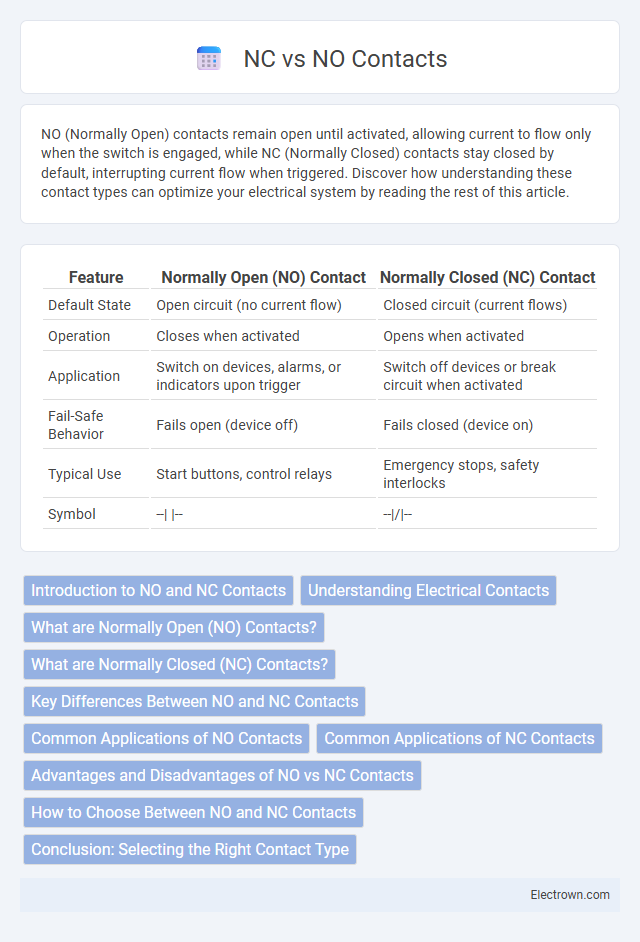NO (Normally Open) contacts remain open until activated, allowing current to flow only when the switch is engaged, while NC (Normally Closed) contacts stay closed by default, interrupting current flow when triggered. Discover how understanding these contact types can optimize your electrical system by reading the rest of this article.
Table of Comparison
| Feature | Normally Open (NO) Contact | Normally Closed (NC) Contact |
|---|---|---|
| Default State | Open circuit (no current flow) | Closed circuit (current flows) |
| Operation | Closes when activated | Opens when activated |
| Application | Switch on devices, alarms, or indicators upon trigger | Switch off devices or break circuit when activated |
| Fail-Safe Behavior | Fails open (device off) | Fails closed (device on) |
| Typical Use | Start buttons, control relays | Emergency stops, safety interlocks |
| Symbol | --| |-- | --|/|-- |
Introduction to NO and NC Contacts
NO (Normally Open) and NC (Normally Closed) contacts are essential components in electrical circuits that control the flow of current based on their default states. NO contacts remain open when the device is inactive, allowing current to flow only when actuated, while NC contacts stay closed by default, interrupting current flow when triggered. Understanding the difference between these contact types helps you design and troubleshoot circuits effectively, ensuring proper operation of switches, relays, and control systems.
Understanding Electrical Contacts
Electrical contacts are fundamental components in circuits, classified primarily as Normally Open (NO) or Normally Closed (NC) based on their default state without external actuation. NO contacts remain open, preventing current flow until activation closes them, commonly used in push-button switches and relay coils to initiate circuits. NC contacts stay closed by default, allowing current to flow until activation opens them, frequently employed in safety and emergency stop functions to break circuits.
What are Normally Open (NO) Contacts?
Normally Open (NO) contacts are electrical switches that remain open when in their default, unactuated state, preventing current flow until activated. These contacts close to complete the circuit only when an external force, such as a mechanical switch or relay coil, triggers them. You can find NO contacts commonly used in control and automation systems to initiate actions when a specific condition is met.
What are Normally Closed (NC) Contacts?
Normally Closed (NC) contacts are electrical contacts that maintain a closed circuit in their default state, allowing current to flow until an external force or signal causes them to open. These contacts are commonly used in safety and control circuits to ensure that devices or systems remain active unless intentionally disrupted. Understanding NC contacts helps you design reliable safety mechanisms and fail-safe operations in various electrical applications.
Key Differences Between NO and NC Contacts
NO (Normally Open) contacts remain open when the relay or switch is inactive, allowing current to flow only when the device is energized. NC (Normally Closed) contacts stay closed in the inactive state, enabling current flow by default and opening only when activated. The primary difference lies in their default states, impacting circuit design choices based on whether power flow is desired during active or inactive conditions.
Common Applications of NO Contacts
NO (Normally Open) contacts are widely used in applications such as push-button switches, alarm systems, and lighting controls where circuits need to complete only when activated. These contacts remain open until an external force or signal closes them, enabling current flow. Common devices leveraging NO contacts include doorbells, safety interlocks, and relay coils for automated processes.
Common Applications of NC Contacts
NC (Normally Closed) contacts are widely used in safety and fail-safe applications where the circuit must remain closed during normal operation and open when an issue occurs. Common applications include emergency stop buttons, brake controls, and alarm systems, ensuring immediate disconnection to prevent hazards. They provide reliable protection by breaking the circuit automatically under fault conditions or when power is lost.
Advantages and Disadvantages of NO vs NC Contacts
NO (Normally Open) contacts remain open when the device is inactive, closing only during activation, which prevents circuit flow and reduces energy consumption until triggered; this design is advantageous for safety systems needing default off states but can be prone to false activation from electrical noise. NC (Normally Closed) contacts stay closed, allowing current flow by default and breaking the circuit upon activation, offering reliability in maintaining continuous operation and immediate shutdown during faults, yet risking power drain and potential wear from constant conductivity. Your choice between NO and NC contacts depends on balancing fail-safe requirements against energy efficiency and circuit stability in your specific application.
How to Choose Between NO and NC Contacts
Choosing between Normally Open (NO) and Normally Closed (NC) contacts depends on your system's safety and operational requirements. NO contacts remain open until activated, making them ideal for start functions or systems that should engage only when triggered, while NC contacts stay closed until deactivated, providing a fail-safe state useful for emergency stops or alarm circuits. Understanding your circuit's default state and desired response ensures you select the right contact type for reliable performance and safety.
Conclusion: Selecting the Right Contact Type
Selecting the right contact type depends on your application's specific needs for circuit control and safety. NO (Normally Open) contacts are ideal for circuits requiring activation only during a triggering event, ensuring energy efficiency and reduced wear. NC (Normally Closed) contacts provide fail-safe operation by maintaining circuit continuity, crucial for emergency or safety systems where power loss must be detected immediately.
NO vs NC Contacts Infographic

 electrown.com
electrown.com